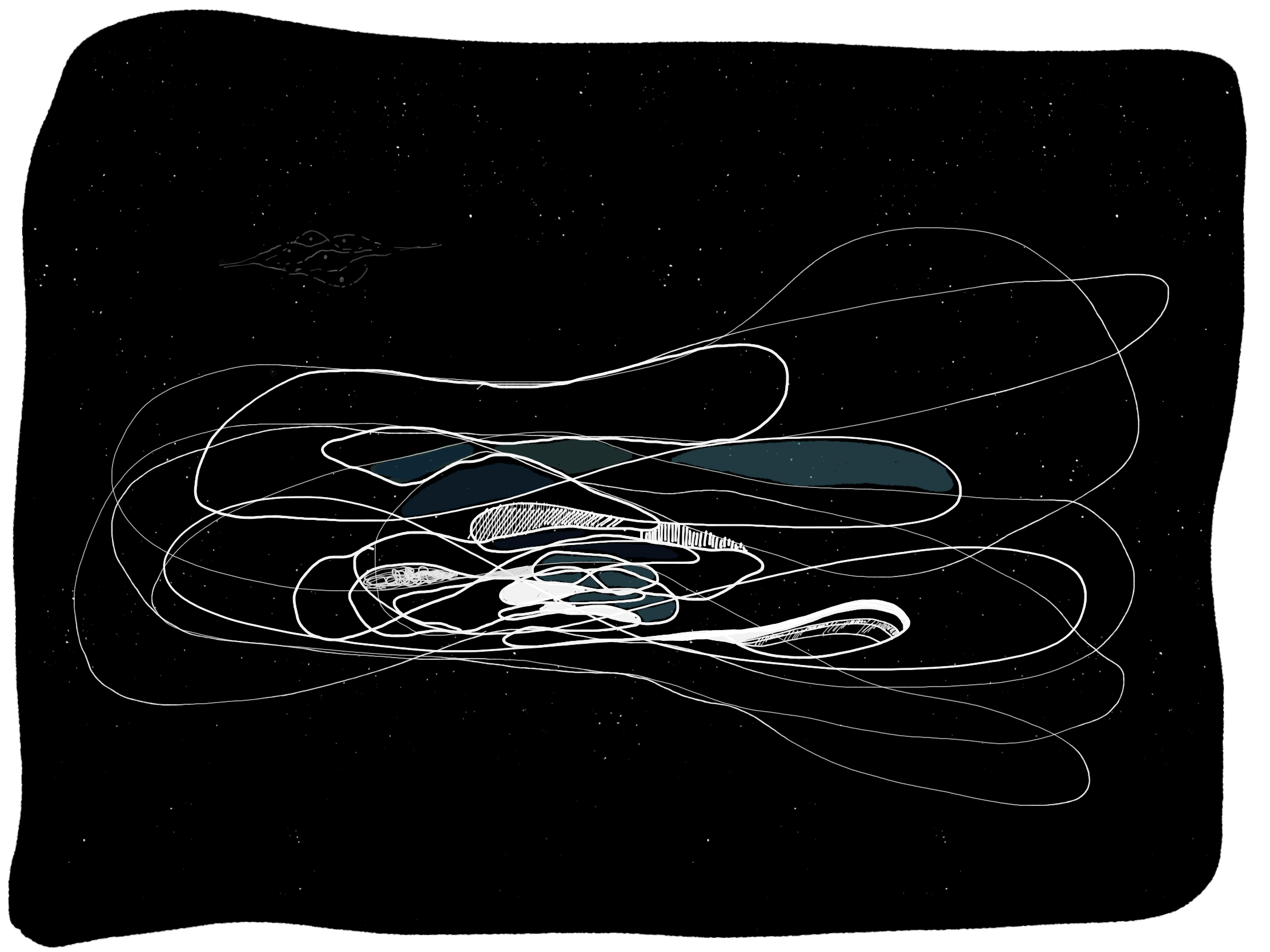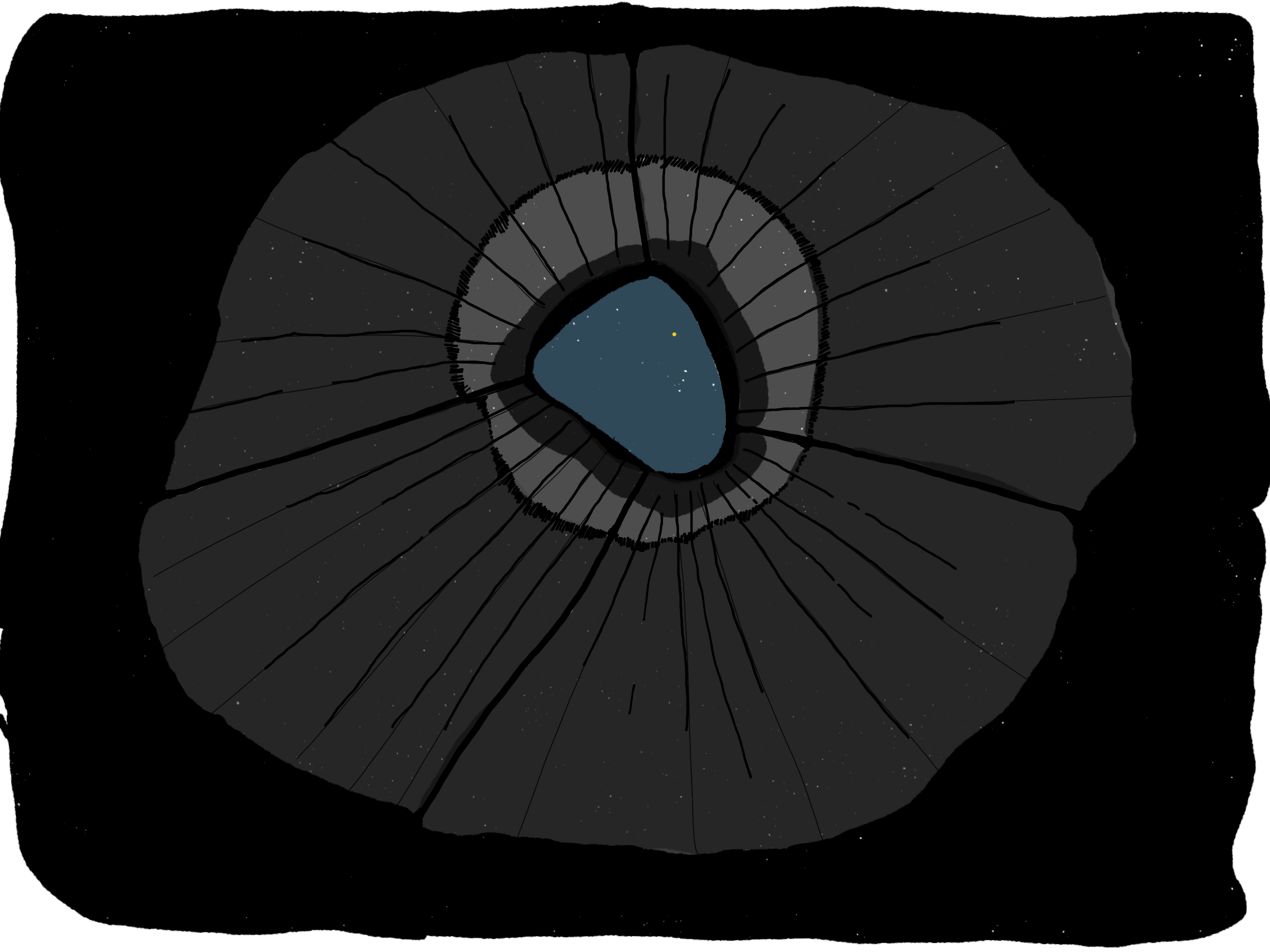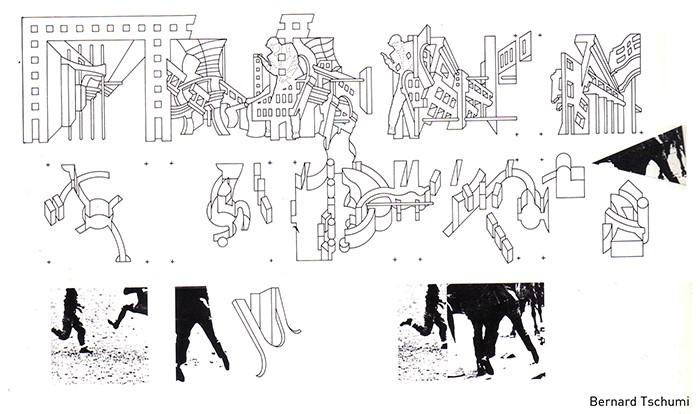



















If we have been evolved as the mass and the speed of a comet, we would have been generally lonely for the entirety of a life time. Imagine the beauty of the vast dark space, no light to shine upon you therefore nothing visible in sight. We probably may not have developed organs for sight anyway, but interesting still to imagine with our humanly senses, to imagine what it feels like to be a comet.
There are moments the comet encounters with other beings. Like for instance the ESA (European Space Agency) spacecraft. An alien sits on top of you, towards your aimless, timeless journey, like a mosquito, draining your blood, without even you realize what is going on. It is not even a blip in time, because there is no time. It would have been horrendous to imagine the existence of time at the space. (The preposition ‘at’ seems so inappropriate to talk about space).
The comets have been observed from a single point of view as extremely fast entities, passing on a blip in time, but if you were one, you would have been still. Unimaginably still, like nothing our human senses can perceive. There are multiple spatial dimensions in this stillness. You are one-dimensional, a dot, because well, the space is infinite(?). Two dimensional, as you leave your trace, for other observers. Three- no reason to explain. 4th – and 5th… who know what else is going on there, events fold into each other, because there are no events. An impact — with the sun! Really? Ah God, who would have thought I have been under its gravitational pull..

There will be a series of writings here about time and eventually all things related to it. It has been a while since I last wrote, therefore hoping to slowly improve the thought organization. It might be a bit confusing and unrelated in the first place.
Time- it is a perceptive and real entity. Real, since it is bounded with space forming a fabric in higher dimensionalities. Perceptive for human beings, since it is about how fast the Earth revolves. Our biological clocks set up for millions of years, adopting to the position of sun to receive the maximum necessary amount of energy to grow.. Grow and populate and make up systems working as a whole.
Sun sets and rises, repeatedly, over and over for a vast amount of period. It is repetition, which is security. Predictability gives a certain feeling of security, so one can grow. Like the family nourishes the baby, protects from unknown to them. Maybe sun therefore has been seen as the god in pagan ages. Evolved later to the human figure-father.
Repetition is what is called as time. The conscious develops reason from the chronological order. Creates meaning, feels safe and ordinary, develops the common sense.
Whereas mind, understands it differently. There is past, and learned experiences. But the way the experiences are stored are not a thing at the past. It is a live system, past happens now and now changes past. It is the key memories, like heavy celestial bodies, pulls the fabric around it, bends our understanding and makes us remember by being prominent.. Diverging and converging lines shaped around the nodes, these memories, in the end make up the whole fabric of oneself.
So what is time really?
This article is published in Arredamento Mimarlik Magazine July/August 2019 issue in Turkish
Orkun Beydagi
Information is an entity that occurs in the relationship between the object and the subject and describes the relations within this duality. These relationships occur in different situations and forms, such as data, information, accumulated/acquired knowledge, understanding, and wisdom. In the article, the focus will not be on these different relationships but on the processing processes of the data and information.
Data and information go through certain elimination and classification processes during the transition to acquired knowledge. These processes, which are experienced for both archiving and instantaneous use, define the taxonomic relationships of information. The classified data and information begin to form a meaningful expression with this new state and are processed into the repertoire.
In the context of urban Information, the situation to be defined within the scope of this subject would rather cover the information of the program and related urban activities carried out in the city. From large-area zonings to single-person locations, the city will be viewed as a self-reprogramming entity with a holistic view into a systematic whole of programs.
Urban program-reprogramming
Modernity has treated cities as a machine, like all other beings, and divided cities into rigidly defined functional areas, leading to a hill-bottom planning approach. In particular, the ‘functional city’ was defined together with the decisions of CIAM on city planning, which had been taken in the 1933 Athens Charter, and the city was divided into regions based on the principle of zoning. The city, consisting of sub-layers such as residential, commercial, industrial and agricultural, was divided into specific clusters of with certain ranges of life and time through transitions between these sub-layers and its boundaries were determined by cartesian geometries. One of the important principles of urban planning, time, is here thought as the time indicated by a mechanical clock; Bergson’s concept of ‘duree’, which could be explained as interval or perceived duration, was not considered. The city emerges as a finite, solidified object, subject to analysis, describing itself with its physical form. Kwinter sees this as an absolute fallacy and states that each city consists of areas of force that combine historical methods in a dynamic composition in a specific and idiosyncratic manner, which are in motion and constantly organized (2010).2 the Real Time Rome project, a work carried out by MIT’s Sensible City Laboratory, is focused on storing/processing its data by reading and visualizing the city through these different fields of force. Thus, the areas and vectors of the city with transforming dynamics become visible above the geometric layer.

Figure 1 – Functional City

Figure 2 – Real Time Rome
This refers to a previously defined condition, in which cities are treated as a whole and as self-organized and self-reprogramming entities. The condition that the urban program can be self-organized absolutely depends on the activities of the users and the way they use the city. Cities can be defined as infinite data producers in which people produce information when they are regarded as the playground of multifaceted activities. People create “perceived programs” for the city in the activities they participate in as users of the cities. Although the program dictated by the urban environment is specific, this perceived program is in constant motion. This point can also be explained by Tschumi’s spatial and programmatic sequences. According to Tschumi, architecture, in its settled form, is conflated with events, uses, activities, sequences of cases, and fixed spatial sequences. These consist of hidden maps and improbable fictions as programmatic sequences and spanned event collections, followed by spatial collections as frames, places, and sections (1996).

Figure 3 – Manhattan Transcripts
Although the sequences identified here are defined as very special cases, the possibility of defining a pattern can be ensured when there is the possibility of being examined at higher scales. When evaluated through the parallax of Zizek, events may carry similar characteristics if viewed from different perspectives, and these characteristics may momentarily fall into different classifications.
Location of user activities and data generation
In communities whose user activities and relationships are not defined through their everyday economic and political practices, the relationship with the urban program can be more creatively defined. According to the situationism theory, daily activities are reformulated. ‘New Babylon’ stands out as an example where user activities are transformed into creative games, as a result of which the new economic and political structure is derived and changes the social structure of the community. According to Simon Sadler, New Babylon’s architect constant’s interest in urban planning is a result of his observations as a ‘flâneur’ in Paris and London (1999)- such as “the actions of people such as construction, demolition, extraction”; “their drive away with the increase of traffic”; and “mechanised technological progress”.
In these circumstances, the activities described by the users in the city can be looked at individually, which reveals the importance of singular ‘locations’ rather than the functional importance of large areas in the city. Each user connects his/her activities and location to a new function that he/she describes. At this point, the storage of data and information about the location is in question. The city is not a singular entity, but it is a state of overlap of locations. If we go to a definition for the concepts of location and space, location is the place where a situation/activity takes place in the singular moment, while space can be used for the place where wider times of activity overlap each other.
Each user in the city collects and produces continuous data about the city and its location through their actions. The data that emerge in forms of visual, auditory, narrative, intellectual, etc. information have become both archivable and shareable, especially with the development of mobile technologies. This form of data generation, which combines the mental domains of users with their physical environment, increases the capacity of users to gather, engage, archive and share with the help of location-dependent social networking technologies.

Figure 4 – Users percieve the city in their individuality and stores that information
The capacity to archive and share adds another feature that the city user has not had before: it generates objective or subjective data and information about its position/location. Urban planning has now ceased to be a specialty. The unpredictable and rapid nature of the archive system (internet) has given the hands of everyone with a telephone line and a storage unit much scientific action and political method that cannot even be produced by thinned and disciplined time and methods (2010). Urban users participate in urban life with their mobile devices and transform it. From the local context to the global context, they consciously or unconsciously cause a transformation in their locations and places. This generation of data/information accumulated over locations begins to transform into acquired knowledge that will transform them.
Data/information taxonomy
Generation and knowledge and design of urban data/information generation should follow a different taxonomy than zoning and top-down programming in the face of this new method of information generation. This taxonomy can also be recaptured by methods in which different patterns store and devise information when the way information is produced is also taken into account. The fact that the city is able to create layers of information that pass into each other formed from this information causes the constantly generated and changing information to be evaluated depending on the location, and this valuation is expected to reveal the potential for forming active links between different parts of the city.
Data/information deposits related to the above-mentioned location may be superposed according to the way they occur at different times. This temporal layering creates space memory (acquired knowledge). Individual location data layering can also be spread across the city scale in the form of network formations by interacting with each other. As a more concrete example, we can say that with existing social networking technologies, different people can record and share the same activities from different locations in the city and establish a virtual togetherness in this sense. Remote togetherness connects forms connections among different points of the city, putting the spatial memory of the locations into a system that is in constant motion. This system takes the place of linear program taxonomy, in the form of an instantaneously changing and recorded network pattern. As the closest example from nature to the pattern model mentioned above, we can give the neurons’ logical structures of learning and evolution.
Network pattern models
The brain processes the information it receives from the outside world at the same time to form a different pattern for each singular situation. Storage of information in the brain consists of the same mechanisms as processing. Each new stimulation continues this processing/hiding motion. Memory occurs at the end of this process and is in fact ambiguous because of the mechanism’s nonlinear behavior. Edelman describes the state consciousness as activities of neuron populations in various parts of the brain. Every moment is special and eternal. Feelings, intuition, images, memories, thoughts, emotions, and pains are always involved into them. In this case, consciousness changes constantly; but it is still in a single piece state and can be described as ‘remembered now’. All past experiences raise awareness for the present (2004). The recall of moments undergoes a change with information quoted from the present, and this change affects the past information together with the present, just as the present is influenced by the past.
Conscious individuals receive warnings from their environment and they combine to create a singular moment. These singular moments are processed by creating a specific neuron pattern in the brain. This is explained through the ‘The Theory of Neuronal Group Selection’ (TNGS). TNGS is a theory that reveals that the brain is not in a computer-like linear input-output relationship and works by creating adaptive pattern responses. It is based on three doctrines; 1 – Developmental selection: neurons acting together bind to each other throughout the embryological development process. 2- Experiential selection: after the first stage, variation occurs in synaptic forces relative to environmental effects. 3- Re-entry: the parallel repetitive signal exchange between brain regions occurs in temporal space in a way that coordinates between different regions of the brain.

Figure 5 – TNGS
Edelman states in his book that these three doctrines constitute the selective system. Examples of selective systems include the immune system and the nervous system. All of these examples follow three basic principles. The first one provides diversity in the population. The second aims at extensive encounters of individuals in a diverse population. This can also be another ecological environment, an alien module or sensory signal clusters as well. The third principle allows to increase the number of individuals highly and allow interaction in order to achieve the selective criterion (2004).
This described mechanism of the nervous system has evolutionary principles. It is intended that the variation increases the strength of the bonds and that these bonds strengthen under this variety, resulting in other unexpected results with new external effects. This pattern model can be used as a model in the process of transforming the urban data of the location into acquired knowledge and in creating the memory of the space(s). Location-related information; under the three doctrines described above: 1 – Develops in such a way as to provide the highest level of diversity. For example, the activities performed by urban users in the X unprogrammed location shows different variations caused by the variety of users and this activity data accumulate. The accumulation gains momentum on virtual reality as data piles up due to the impact of social media technologies. 2- Accumulated data is affected by new user and program entries with each new activity change. At the same time, similar activities at different locations communicate and interact with the effect of virtual reality and the internet, improving their individual spatial memory. 3- As the spatial memories get stronger, the bond between them is enhanced. Meanwhile, with increased interaction, the nodes in the pattern change, allowing the pattern to leap into other areas.
The evolutionary process of the taxonomy of data/information ensured by the pattern model enables them to transform into spatial memory, that is, acquired knowledge. The types of data at this point are also of primary importance. The contents of the data cause them to be important in the first degree in terms of their formal classification since the person who produces and uses the information produced is human. Because the topic we consider as the material is the data regarding user activities, it requires communication between the other user, who produces and uses the language that emerges as a result of these activities. Regarding this issue, Bateson mentions the characteristics of the forms of communication carried out by mammals in terms of the classification of the data produced. The language people use during communication is purely analogous and consists of the whole of the digital data. The digital form here refers to the language. No word in the language is superior to another. Thus, no word refers to greatness. There is no difference of magnitude between the heavy and light words; therefore they are all digital. However, humans, even mammals, form magnitude relationships between expressions using different forms of communication, such as intonation, gestures and etc. These relations of magnitude, on the other hand, provide analogically inter-entity communication (1972). This is why the stacks of location data can also have different magnitudes as a result of the ability to interpret which is entailed by the fact that the users are human. These magnitudes have an effect on the comparison and selection of data. One important example of this is that as the semantic content of the information generated about a location becomes accumulated, a decrease in tracking/liking rates can be observed compared to the others. This location information remains in small proportions and goes towards extinction by going through a process of selection. This condition parallels the condition described in the first phase of the neuron selection theory.

Figure 6 – Pattern model city diagram
Position of the architectural object in urban reprogramming
Urban reprogramming can be fictionalized in the light of individual and social activities by forming nodes and networks similar to the neuronal firing in the brain. For this reason, the rules created in pattern models and the like appear as a model that provides this condition. This situation differs from the modern paradigm based on zoning, which was determined in the field of urban planning a century ago, and becomes a self-organized system that can adapt itself to today’s developments. In New York City, although the city’s grid structure consists of blocks, each of them appearing to be the same, its program constantly changes as a result of the variations created by its users. Kimmelman mentions the New York grid as a whole of systems, each of which diverges from one another with slight differences (2012). This nonlinear system processes the activity information by transforming it, just as the processing and memory capacity of human brain. The development of mobile technologies enables urban users to connect with their environment through this activity information. Each new second, the city program transforms with the increased impact of mobile technologies on user interactions.
From this point on, can we mention that the change in the city program has an effect on the geometry of the city design and architectural object? Urban geometry refers to cartesian geometries as a result of zoning and linear taxonomy. The city formed by cartesian geometries can evolve with this formal program taxonomy into a whole of systems in which geometries are also deformed by different forces. This opens the door to reconsidering the location and boundaries of the architectural object within the city. Can architecture remain in its singular form in today’s evolving cities, when ownership is disappearing and subscribed services are starting to address our needs? Can a service be considered as a continuously variable entity when the parameters are specified by the user? Or is it able to remain in its particular form, which can set the constant within all this rapid transformation, is slower in transition, and has identified actors?
Notes:
1 Prepared within the scope of the Paradigms on Architecture, ITU Architectural Design Ph.D. Program of 2015.
2 Kwinter here limits the city, describes it through nonlinear processes in which vectors and fields are in a complex relationship with each other, and considers its relationship to the city program on a higher scale, usually a topic related to geometry.
References
Bateson, G. (1972). Steps to an Ecology of Mind. Chicago: University of Chicago Press.
Edelman, G. (2004). Wider than the Sky: The Phenomenal Gift of Consciousness. New Haven: Yale University Press.
Kimmelman, M. (2012, Jan 2). The Grid at 200: Lines That Shaped Manhattan. May 3, 2015 New York Times: http://www.nytimes.com/2012/01/03/arts/design/manhattan-street-grid-at-museum-of-city-of-new-york.html?_r=3&ref=michaelkimmelman
Kwinter, S. (2010). Requiem for the City at the End of the Millennium. New York: Actar.
Sadler, S. (1999). The Situationist City. Cambridge: MIT Press.
Tschumi, B. (1996). Architecture and Disjunction. Cambridge: MIT Press.
Zizek, S. (2006). The Parallax View. Cambridge: MIT Press.